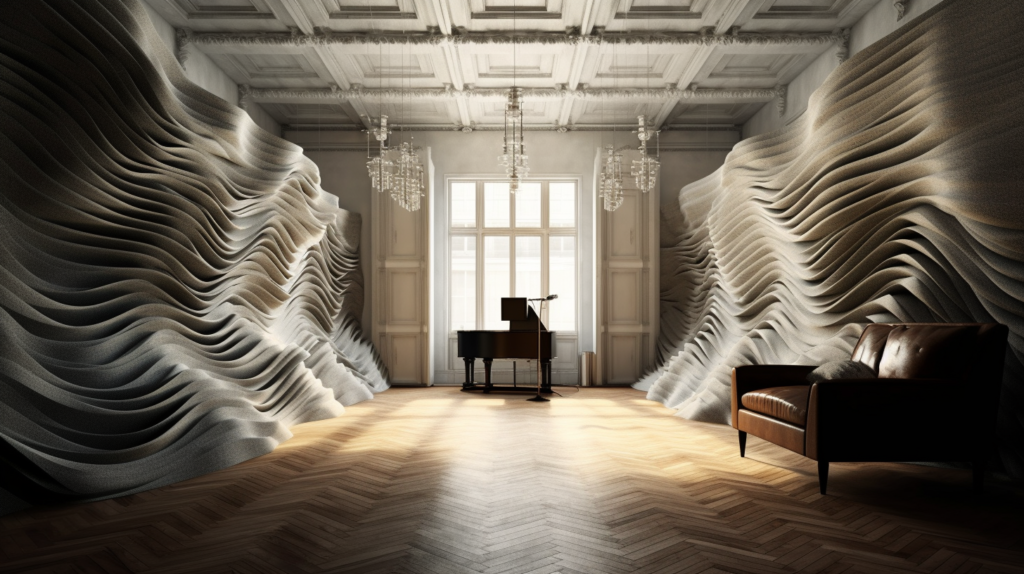Have you ever wondered, “Do soundproof panels actually work?” It’s a question that many people ask, especially when they’re fed up with noisy neighbors, street sounds, or even the cacophony within their own home.
Soundproof panels are not merely decorative elements; they are scientifically engineered solutions designed to tackle a variety of noise issues.
However, not all panels are created equal, and understanding the different types, materials, and applications is crucial for effective soundproofing
So, do soundproof panels work? The answer isn’t a simple yes or no; it’s far more nuanced. Let’s dive into the mechanics of soundproof panels, the materials that make them effective, and how they differ from other noise-management solutions like acoustic panels and foam.
What Are Soundproof Panels?

Soundproof panels are more than just decorative additions to a room or space; they are engineered solutions designed to tackle the problem of unwanted noise.
Often, people confuse these with ordinary wall panels or even acoustic panels, but soundproof panels serve a unique purpose.
They are specifically engineered to minimize the amount of sound that can pass through them, making them an ideal choice for anyone seeking a quieter environment.
But what exactly constitutes a “soundproof” panel? In its most basic form, a soundproof panel is a construction material designed to absorb, reflect, or block sound waves. They come in various shapes, sizes, and types, each with its own set of pros and cons.
Some are designed for industrial settings, where heavy machinery can produce structure-borne noise. Others are better suited for residential environments, where the focus is often on minimizing airborne noises like voices or music.
Understanding the types of soundproof panels available is the first step in choosing the most effective solution for your specific noise problems.
How Do Soundproof Panels Work?

The first thing to understand when diving into the mechanics of soundproof panels is the nature of sound itself. Sound waves are a type of energy that moves through the air, vibrating molecules as they go.
When these waves encounter a barrier, several things can happen. The sound can be absorbed by the material, reflected back into the environment, or transmitted through the material.
The effectiveness of a soundproof panel is determined by how well it manages these interactions.
For airborne noises, the sound waves travel through the air and are captured by the porous material of the panel. The energy from the sound waves is then converted into a different form of energy, typically heat, which is then dissipated.
The result is a significant reduction in the sound levels on the other side of the panel. This is particularly useful for noises like conversations, television sounds, and music.
Structure-borne noises, on the other hand, are much more complicated to handle. These are noises that result from vibrations in the structure of a building, such as when heavy machinery is operating or when someone is walking upstairs.
These vibrations can travel through walls, floors, and ceilings, making them much more challenging to isolate and treat. Traditional soundproof panels may not be sufficient for these types of noise, requiring more specialized solutions.
Soundproofing Materials Matter: Use Nitril Butadiene Rubber and Polyester Felt

One of the most critical factors that determine the effectiveness of a soundproof panel is the material from which it is made. The market offers a variety of materials, but among the most effective are Nitril Butadiene Rubber (NBR) and polyester felt.
These materials are not just randomly chosen; their properties make them particularly suited for soundproofing applications.
Nitril Butadiene Rubber, or NBR, is a synthetic rubber that offers a unique combination of density and flexibility. The density of NBR allows it to effectively block out a wide range of sound frequencies, making it one of the most versatile materials for soundproofing.
Whether you’re dealing with high-frequency noises like bird calls or low-frequency rumbles like construction work, NBR panels can provide a significant level of relief.
On top of that, the flexibility of NBR means it can be applied in various settings and forms, from wall panels to underlayment for floors.
Traditional Acoustic Panels And Acoustic Foam Cannot Soundproof
Acoustic panels and soundproof panels are often confused, but they serve distinct purposes.
While acoustic panels are designed to improve the sound quality within a room by reducing echoes and reverberations, they are not engineered to block sound from entering or leaving the room.
They are usually made of softer, less dense materials like foam, which can absorb sound waves but are not effective in preventing sound transmission.
It’s crucial to understand this distinction when you are looking to control noise in a space. If your primary concern is blocking sounds from entering or leaving a room, traditional acoustic panels may not provide the solution you’re seeking.
These panels are better suited for environments where the internal sound quality is the primary concern, such as recording studios or home theaters. So, while they have their place in the world of sound management, they are not a one-size-fits-all solution for every noise issue.
Acoustic foam is another material frequently encountered in discussions about sound management, but it’s essential to understand its specific function.
Primarily used in recording studios, home theaters, and other environments where sound quality is a top concern, acoustic foam is engineered to absorb sound waves, reducing echo and reverberation within a room.
However, it’s not designed for soundproofing. The foam’s porous and less dense nature allows it to capture sound waves within a space effectively, but it lacks the mass and density to prevent sound from traveling between rooms or other separate spaces.
Therefore, while acoustic foam can enhance the audio experience within a specific area, it’s not the solution for those looking to block external noise from entering or leaving a room.
The Only Exception: Polyester Acoustic Panels But With Catch
There is one type of acoustic panel that stands as an exception in the realm of soundproofing: polyester acoustic panels.
While traditional acoustic panels focus only on improving internal acoustics, polyester acoustic panels offer some soundproofing capabilities, primarily when dealing with airborne noises.
However, it’s important to note that they are not as effective as specialized soundproof panels made from denser materials like NBR.
Polyester acoustic panels are often thinner than their NBR counterparts, which limits their ability to block a wide range of sound frequencies effectively. However, they can still be a viable option for specific applications.
When installed correctly, flush against the wall without gaps, they can offer a level of sound reduction. They are particularly effective at absorbing mid-range frequencies, which include many common sounds like talking or TV noise.
But keep in mind, their thinner and less dense nature makes them less effective for dealing with structure-borne noises or higher frequency sounds.
Conclusion
Soundproofing is a nuanced field with various solutions tailored for different noise issues. While traditional acoustic panels and foam enhance internal sound quality, they aren’t designed for blocking external noise.
For effective soundproofing, specialized panels made from materials like Nitril Butadiene Rubber (NBR) are the go-to choice. Polyester acoustic panels offer a middle-ground solution, effective for certain types of noise but not as comprehensive as NBR panels.
Knowing the difference empowers you to make informed decisions for a quieter environment.
